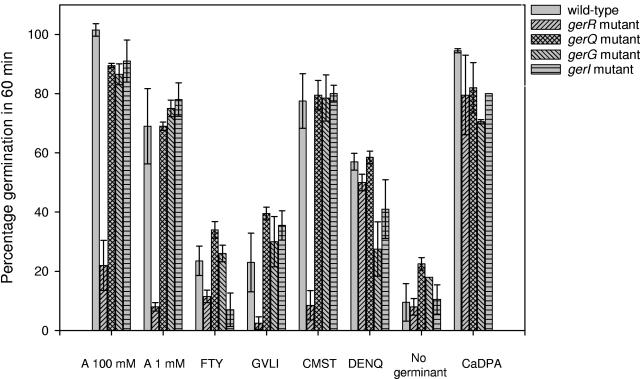FIG. 1.
Germination survey of B. cereus ATCC 14579 wild-type spores and spores of the seven ger mutant strains with 20 amino acids. The percentage of germination was monitored after 60 min of incubation with the germinant molecules. The bars represent the responses of spores of the wild-type, gerR mutant, gerQ mutant, gerG mutant, and gerI mutant strains. The responses of the mutants with disrupted gerS, gerK, and gerL operons were similar to those of wild-type spores and were omitted for clarity. The amino acids alanine (A) and proline (not shown) were surveyed as single germinants, and the remaining amino acids were surveyed in groups in the following combinations: FTY (phenylalanine, tyrosine, and tryptophan), GVLI (glycine, valine, leucine, and isoleucine), CMST (cysteine, methionine, serine, and threonine), a group with lysine, arginine, and histidine (not shown), and DENQ (aspartate, glutamate, asparagine, and glutamine). The final concentration of each amino acid in these groups was 1 mM, except for tyrosine (0.5 mM). The addition of proline and the mixture of lysine, arginine, and histidine did not result in germination in any of the strains, and these results were omitted from the figure for clarity. Calcium DPA (CaDPA)-induced germination proceeds indirectly by activation of the cortex lytic enzymes, bypassing the germination receptors. Spores of all strains should have responded equally, and this was evaluated by assessing the germination response upon the addition of 50 mM calcium DPA. The results shown are the averages of duplicate experiments completed with two independent spore batches.

